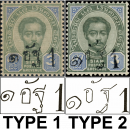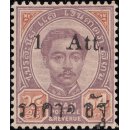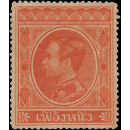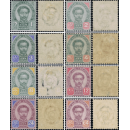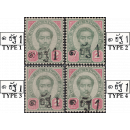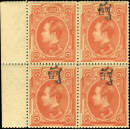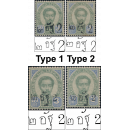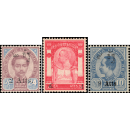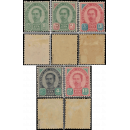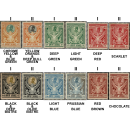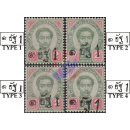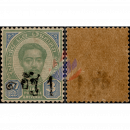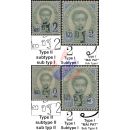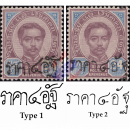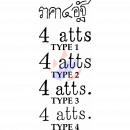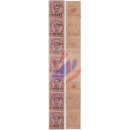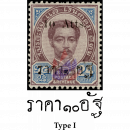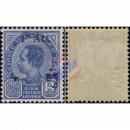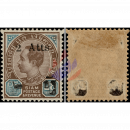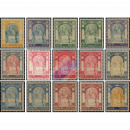-
RAMA V (1830-1910)
King Rama V Chulalongkorn (October 1, 1868 - October 23, 1910)



 Chulalongkorn, or Rama V, the Great (reigning name: Phra Chunlachom Klao), was born in Bangkok on September 20, 1853, and died in Bangkok on October 23, 1910. He was King of Siam, present-day Thailand, from 1868 until his death. During his 42-year reign, Siam continued to open itself to the West, modernized its military, administrative system, education, and legal systems, expanded its infrastructure, and abolished serfdom.
Chulalongkorn, or Rama V, the Great (reigning name: Phra Chunlachom Klao), was born in Bangkok on September 20, 1853, and died in Bangkok on October 23, 1910. He was King of Siam, present-day Thailand, from 1868 until his death. During his 42-year reign, Siam continued to open itself to the West, modernized its military, administrative system, education, and legal systems, expanded its infrastructure, and abolished serfdom.
As king, he adopted the throne name Phra Bat Somdet (Phra Paraminthara Maha Chulalongkorn) Phra Chunlachom Klao Chao Yu Hua, by which he is still referred to in Thai documents, publications, and historical works. However, he signed himself Chulalongkorn Po.Ro., where Po.Ro. stands for ParamaRachathirat (roughly "supreme king of kings"). He continued to call himself Chulalongkorn even abroad, which is why this is the most common name for this king in Western literature. The universities named after him are also called Chulalongkorn University and Maha Chulalongkorn Rajavidyalaya. The throne name, however, is used in the name of the Order of Chula Chom Klao and the Chulachomklao Military Academy, which are also named after him.
Beginning of the reign - phase under regency
While observing the solar eclipse of August 18, 1868, in the jungles of southern Thailand, his father and 15-year-old Chulalongkorn contracted malaria. King Mongkut died on October 18 of that year. Many observers expected that his eldest surviving son of the same rank would succeed him on the throne ? this seemed a given, especially to European foreigners. However, it was not inevitable, as Siam had neither a legal nor a customary succession system, and his father had not appointed a successor after the death of his brother and "second king" (Uparat) Pinklao. Instead, a Grand Council composed of princes, high officials, and clerics decided who would become the new king. Besides Chulalongkorn, his much older cousin, Prince Wichaichan, Pinklao's son, was also considered. At the instigation of Chaophraya Si Suriyawong (Chuang Bunnag), his father's highest-ranking and most powerful minister, Chulalongkorn was elected king, Si Suriyawong was appointed his regent, and Wichaichan was appointed the new Uparat. By appointing a "second king," the council and Si Suriyawong anticipated a decision that should have been the responsibility of the king himself. Chulalongkorn's health was still very fragile at the time, but he recovered. Until his adulthood and actual coronation in November 1873, power rested with the regent. Chulalongkorn showed an early interest in the situation abroad. In March and April 1871, he visited the island of Java, part of the Dutch colonial empire, and the British colony of Singapore. In December of the same year, he traveled to British India and Burma to become acquainted with the European-influenced administration there. British Consul General Thomas George Knox accompanied him, as did a group of young princes and aristocrats handpicked by the king. These later formed the core of Chulalongkorn's political support group, known as the "Young Siam" party.
First reformsWhile still regency, Chulalongkorn strove to modernize and centralize Siam's financial system. Until then, much state revenue went to various agencies and ministries controlled by powerful aristocratic families, but not to the royal household. The tax-farming system also proved inefficient, with many tax farmers failing to make their due payments. As early as 1870, the young king established an audit office. After coming of age in 1873, he established the Ho Ratsadakon Phiphat ("Hall of Revenue Development"), a European-style fiscal authority, the forerunner of today's Thai Ministry of Finance. This placed tax farmers under stricter supervision and was intended to prevent collusion between the farmers and their overseers to the detriment of the king's coffers. Another radical change in the state organization was the establishment of the "State Council" (Sapha thi prueksa ratchakan phaen din, "Council for Consultation in the Government of the Empire") in May 1874. Officially intended only to develop proposals for reforms, this body became the central legislative and administrative body of Chulalongkorn's absolutist rule. It was likely modeled on the French Conseil d'État during the time of Napoleon Bonaparte. The most important points on the council's agenda were the abolition of corvée labor and slavery, as well as the prohibition of gambling, which was the most common reason for falling into debt bondage. In August 1874, a Privy Council was introduced, whose (initially 49) members were to advise the king personally.
Front Palace IncidentThese radical reforms met with rejection and resentment from traditional aristocratic elites, who feared for their ancestral prerogatives. Just one year after Chulalongkorn assumed power, a political crisis erupted. It is known as the "Front Palace Incident" after the residence of the Uparat ("second king"). At that time, the Uparat maintained his own guard, quartered on the grounds of his palace. After a powder keg exploded and a fire broke out on the grounds of the Grand Palace, Chulalongkorn's residence, the viceroy's armed troops marched outside its walls, ostensibly to help extinguish the fire. However, the king feared a palace revolt in favor of Wichaichan, so his guard repelled the Uparat's units and extinguished the fire himself. Wichaichan, fearing retaliation from Chulalongkorn, fled to the British Consulate. Siam was on the verge of civil war. After mediation by the British governor of the Straits Settlements, Wichaichan was able to return to the front palace, but had to give up the prerogatives of a "second king." The crisis likely stemmed from the conflict between Chulalongkorn's supporters, who favored his reforms, and conservative elites who supported Wichaichan. Although the king appeared to have emerged victorious from the conflict, it showed him how tenuous his power base was and how dangerous his rapid reform policy was. As a result, he postponed many of his reform projects for extended periods. The councils initially ceased to meet, the fiscal reforms were initially not implemented, and slavery continued for over two decades. Chulalongkorn called on his young supporters to treat the established notables with more respect and to close their "Young Siam Society" and its associated newspaper.
Question of succession to the throneFollowing the death of his viceroy (Uparat), Prince Wichaichan, in 1885, King Chulalongkorn abolished the office of viceroy and instead established the appointment of an heir to the throne as crown prince. In January 1887, he appointed the nine-year-old Chaofa Prince Vajirunhis as Siam's first crown prince (sayam makut ratchakuman). Following the young crown prince's death on January 4, 1895, the king declared his fourteen-year-old son, Vajiravudh (the future King Rama VI), the new crown prince.
The Inner PalaceThe Inner Palace, or Inner City (in Thai, Khang nai or Fai nai, "the inner"), was a geographical, institutional, and social space where exclusively women who had some connection to the king resided or lived. During the Inner Palace's heyday, there were approximately 3,000 women here, with men?except for the king, whose private quarters were located in the Inner Palace, and his sons under the age of 11?being barred from the area. It was thus a harem three times larger than the most extensive harems in the Ottoman Empire. Chulalongkorn had a total of 153 wives, of whom 35 bore him 76 children. The other (female) inhabitants of the Inner Palace included concubines, guards, judges, moneylenders, cooks, servants, and slaves..
The legacy of Chulalongkorn
He left his son, Vajiravudh (Rama VI), who had already studied in England, a modern state with diverse opportunities for the development of individual citizens. Chulalongkorn remains one of the most revered figures in Thai history in his homeland.
If you are missing issues or are looking for specific issues, are looking for an auction representative in Thailand, or have any questions about philately, please CONTACT us via our "CONTACT SYSTEM".
-
-

-
10 Atts. on 24 Atts. 1895
Overprint stamps 10 atts on 24...
-
-
-
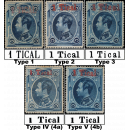
-
1885 - 1 TICAL OVERPRINT
THE TICAL SURCHARGES OF 1885 ISSUED JULY...
-
-
-
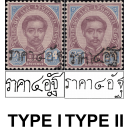
-
4 Atts on 24 Atts 10.1892
THE 4 ATTS SURCHARGES ONLY IN...
-
-
-
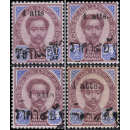
-
4 Atts on 24 Atts 11.1892
THE 4 ATTS SURCHARGES IN ENGLISH...
-

